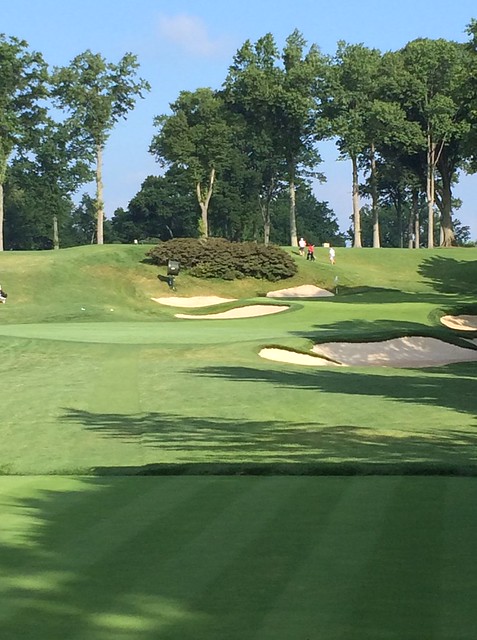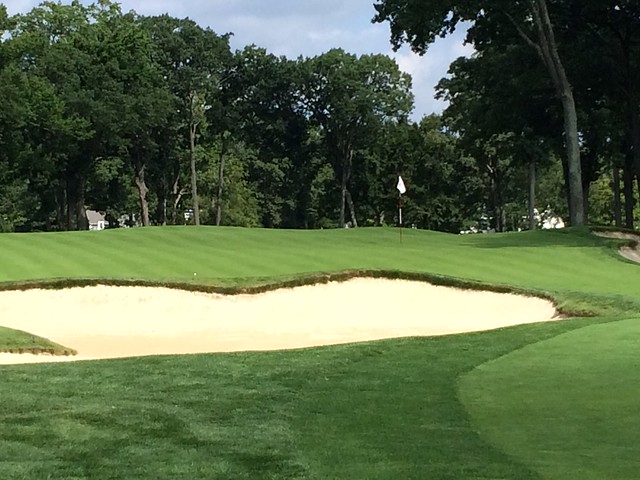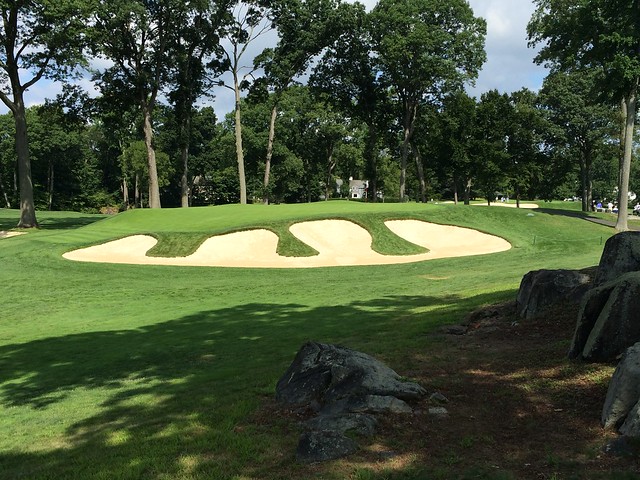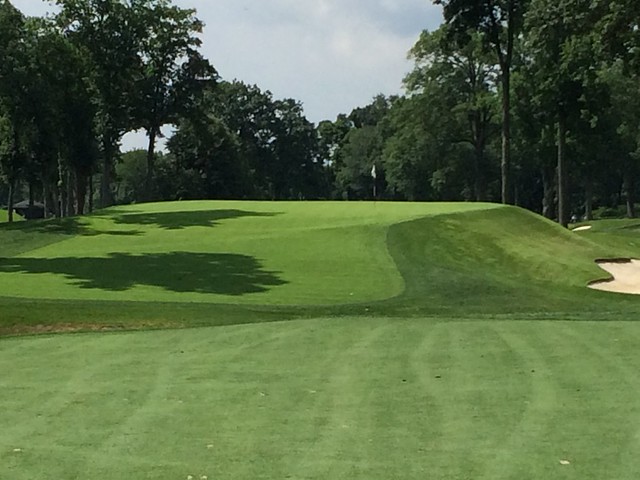There has been much written about many of the world's greatest golf courses: Herbert Warren Wind gushing about Dornoch and Ballybunion; several books have been written about Bethpage; the romance of Hogan's Alley at Riviera, etc. The course in the top 100 rankings which gets little written about it is Winged Foot's East Course (ranked #66 in the world) designed, like the West, by A.W. Tillinghast. How is it that a course that ranks higher than Valderrama, Cruden Bay and Yeamans Hall is highlighted so little? Could it be that the course if simply riding the coattails of its bigger brother Winged Foot West (ranked #18 in in the world)? Which holes make it a top 100 course exactly?
I am blessed to live close to so much good golf and was fortunate to play Winged Foot East and West back-to-back on the same day so I could have a fresh comparison of the two courses. I didn't do justice to the East course on my first trip, so this post will focus on it.
Winged Foot is the only club in the world that has two ranked courses on my list, although a strong case can be made for both Sunningdale and Royal Melbourne to have two, but that's another story. Both golf courses at Winged Foot opened for play on September 8, 1923.
The defining characteristics of both courses are the greens, which almost all slope back-to-front and have narrow entry areas. In the 1920s the press dubbed them "bottle-necks." Being above the hole is not recommended. In their 1923 brochure announcing the opening of both courses, the golf committee warned the golfer about the first two holes on the East course. "A dollar bill couldn't lie level on either of the first two greens with their pitches and roll." The second hole is named "Man O'War" because of the necessity of keeping your shot left, or, as in horse racing, in the pole position, to keep out of trouble. At the time of the course's opening "Man O'War" was a popular race horse.
The par three sixth hole, Winged Foot East, "Trouble"
The par three sixth plays uphill and is about 200-yards long. The hole's name, "Trouble,"--aside from the pitch of the green and the bunkers--is derived from the fact that there is O.B. down the entire right side. It has classic Tillinghast bunkering.
One of the defining features of Pine Valley is how each of the holes are isolated from the others. Not so at Winged Foot, where you see other holes when playing your hole and essentially have vistas of the whole property while playing.
Although all the greens on the course slope back-to-front there is never a time you think they are unfair; the ninth green, for example, has a hump in the rear that serves as a backstop. Tillinghast's description of Winged Foot sums up how much effort he put into the greens, "The holes are like men, all rather similar from foot to neck, but with the greens showing the same varying characters of human faces." If I do have one small criticism of Winged Foot it is, as Tillinghast himself says, that there are many similar holes; I find this to be particularly true on the front nine of the West course where almost a half-dozen holes are of the same basic type tee-to-green. The East has more variety in the style and types of holes.
The tenth hole on the East Course plays back toward the clubhouse and is relatively simple, at only 353 yards. Although, as members will tell you, when the pin is tucked back left in a narrow part of the green behind bunkers, the hole is anything but easy.
The narrow 11th green, Winged Foot East
The eleventh hole is named "Broadway" because like the Great White Way, it bends slightly to the right. This hole is a great illustration of how narrow some of the approaches to the greens are; the difficulty of the greens is in direct proportion to the hole's modest 364 yards. Beware of short par fours. What Tillinghast takes away in length, he makes the golfer pay for around the green. The greens are made to accept shots coming in only on the line of play; being on either side of them you will find yourself playing army golf, marching back-and-forth across the green after failing to hold a delicate pitch shot on them.
The 12th green on the East Course
The par five twelfth is a difficult hole from tee to green and the #2 stroke index hole; what makes it particularly difficult is the approach shot to the green. As the opening day booklet says about twelve, "One big trap almost closes the green in front so the third shot must be pitched." It is a brilliant design, and why the 536-yard hole still gives players fits today. Try to land a long iron or wood into that narrow and well protected target.
The "Cameo", 13th hole at Winged Foot East viewed from the side
Tillinghast was a master of par three design, and the 13th hole on the East course is the best hole on the entire property in my view. Named "Cameo" it plays only 140-yards but is very narrow and requires a perfectly struck shot. As with all of the greens on Winged Foot's East course, if you are left or right, pitching a shot back onto the green requires precision because the greens are only designed to be approached from the front. The picture above is from the side, and you can get a good sense of how narrow the landing strip is from the tee.
The East course only has fifty-three traps, so this is golf of the strategic vs. the penal variety that you may find at a course like Oakmont. Although there are relatively few traps, they add to the scenic beauty of the course because your eye is drawn to them, and they are placed with maximum effectiveness to catch wayward shots.
The 15th hole at Winged Foot East, "Shrine"
The approach to the elevated green on the sub 350-yard fifteenth hole is over a brook, and as see pictured, the green falls off sharply to the right and rear. The East course finishes with a bang. The seventeenth hole is called "Lightning," since a "bolt of Jove" would be required to move the ball from some of the 207-yard hole's traps. The eighteenth is called "Taps," on a course that opens with a first hole named "Reveille," and "sails happily to a rising green."
A strong case can be made that the best stretch of holes on the property are the East course's eleventh through fifteenth. I am a big fan of the East course and personally prefer playing it to the West; I think it has more shot variety and is a more interesting routing.
Both are fabulous courses where you have to hit and hold the greens or you will have a long day. Although my feet hurt after playing 36 holes and from being on them for close to ten hours, my spirits were soaring as we retired to the majestic clubhouse for a drink. The total golfing experience at Winged Foot is the epitome of private American club golf, with its historic grand clubhouse, experienced and learned caddies, and world-class courses. Those that only play the major championship-hosting West course are missing something special if they skip the East.










